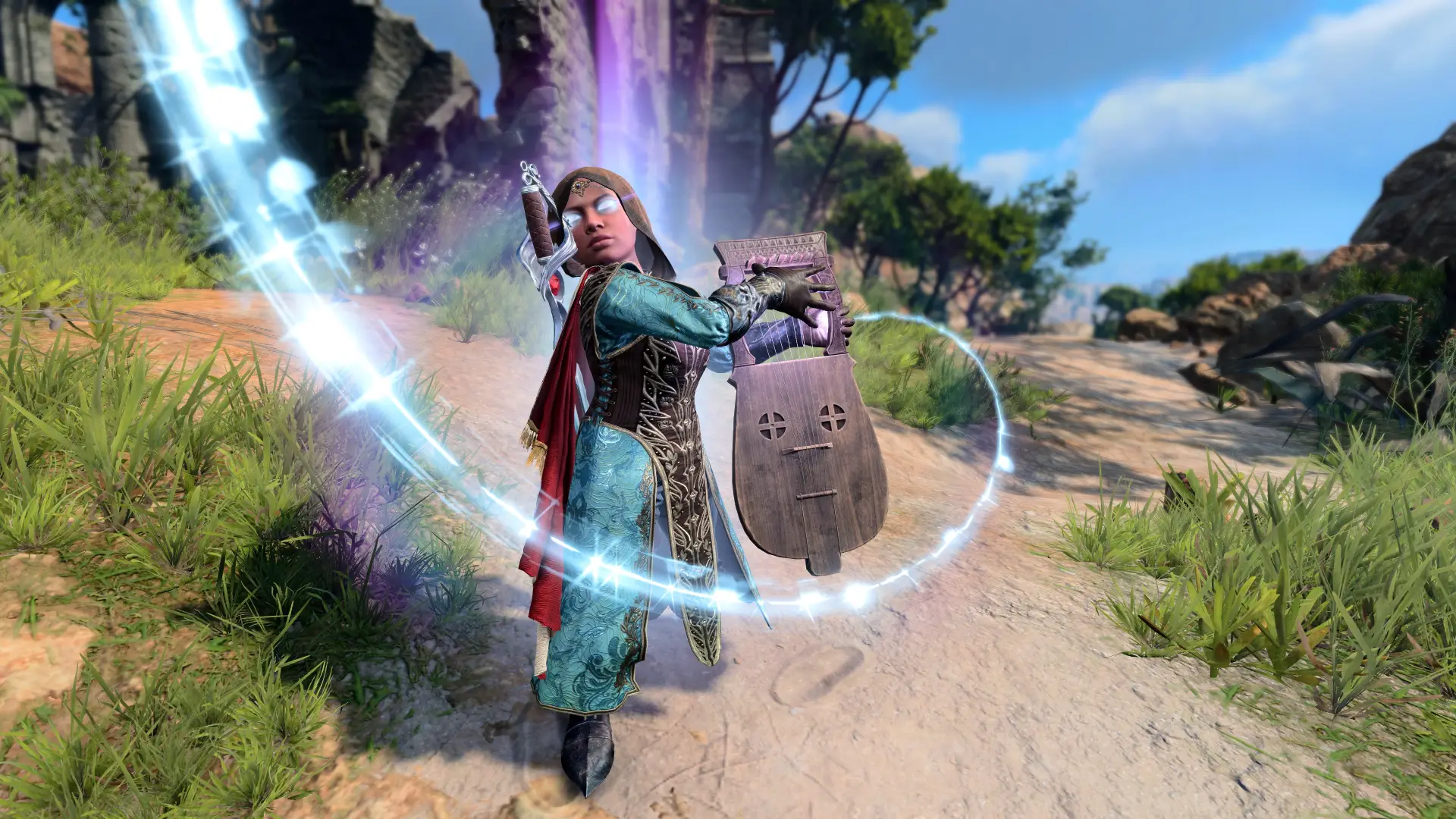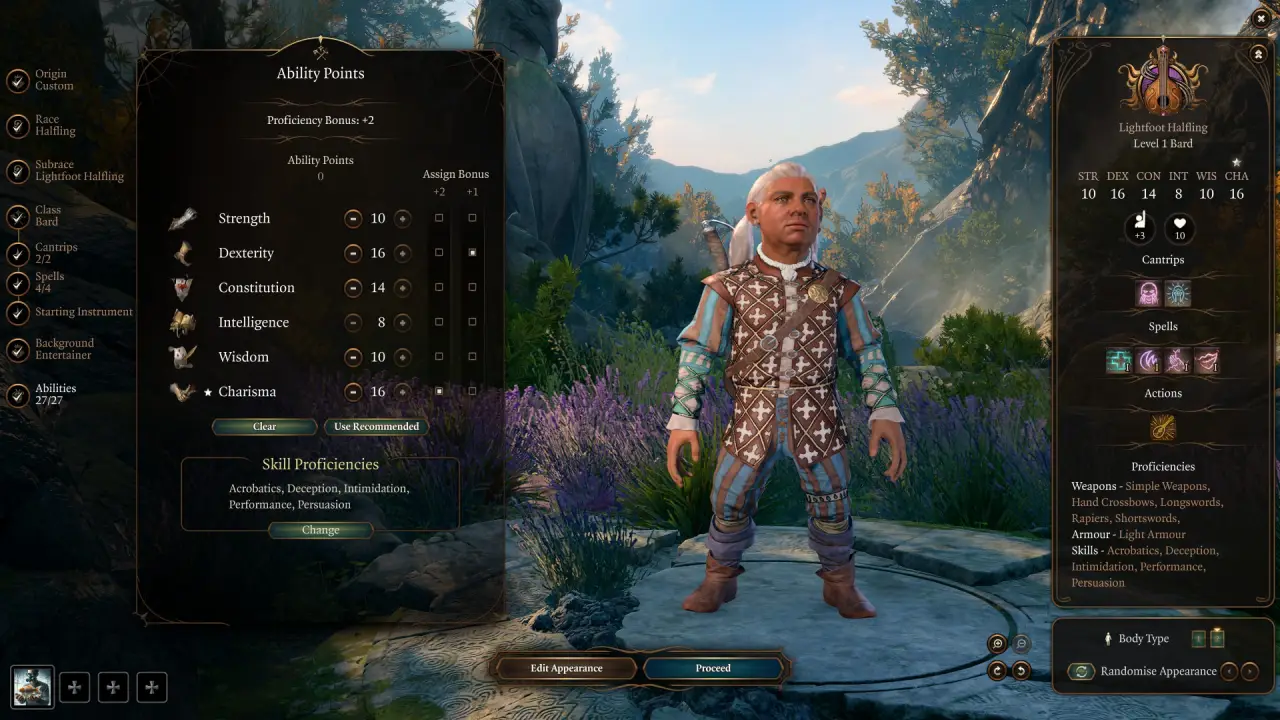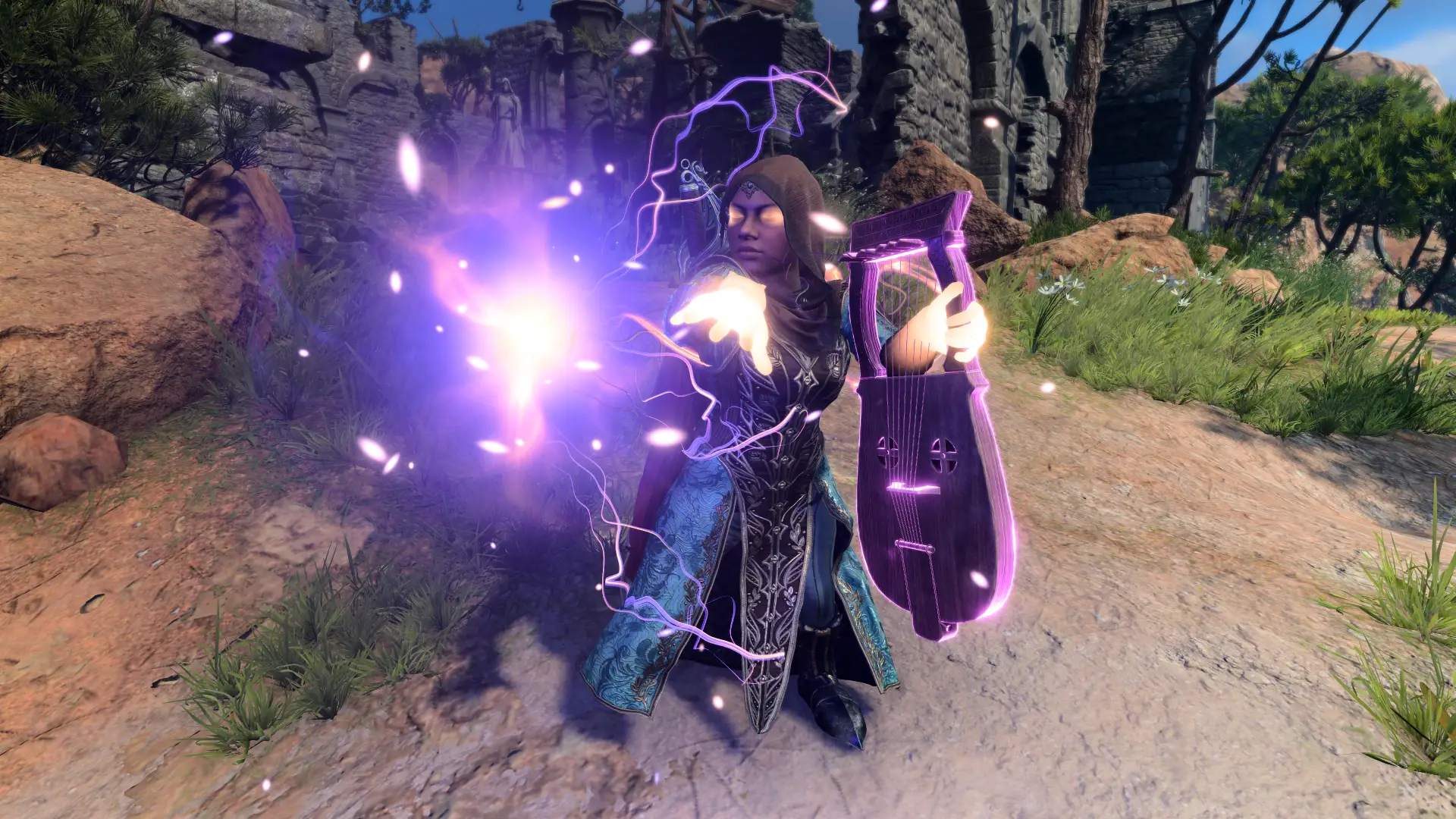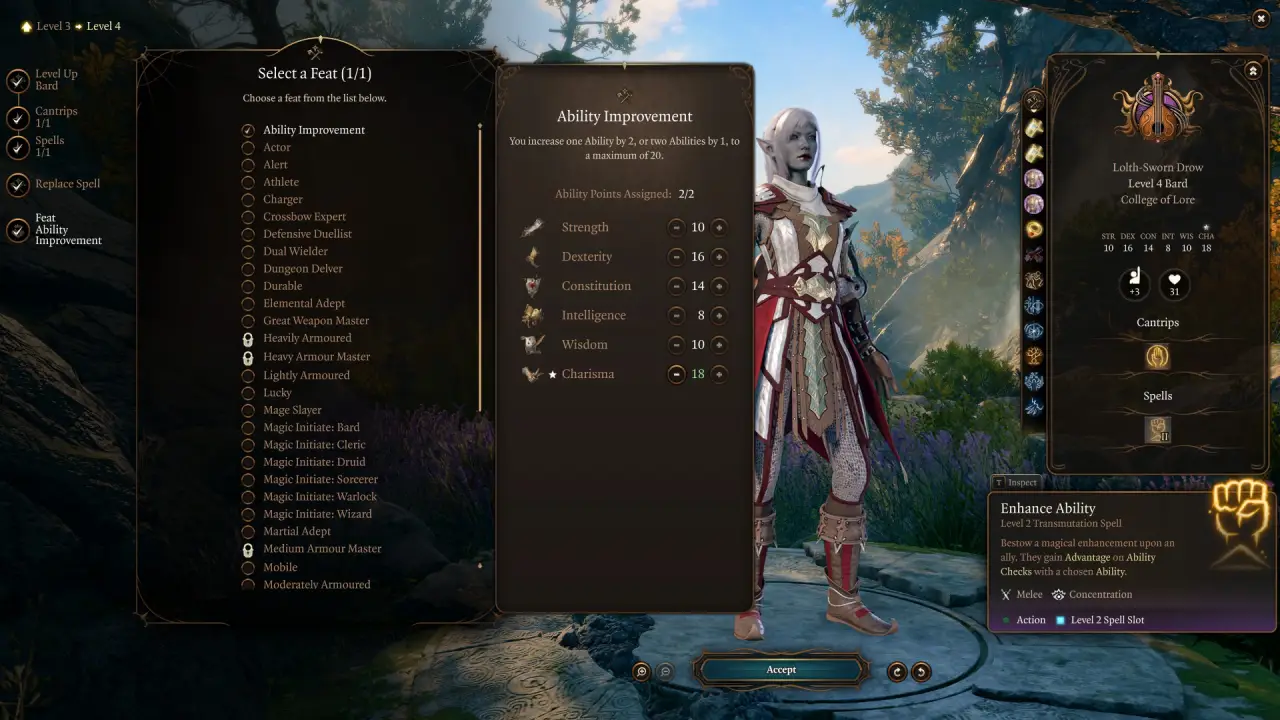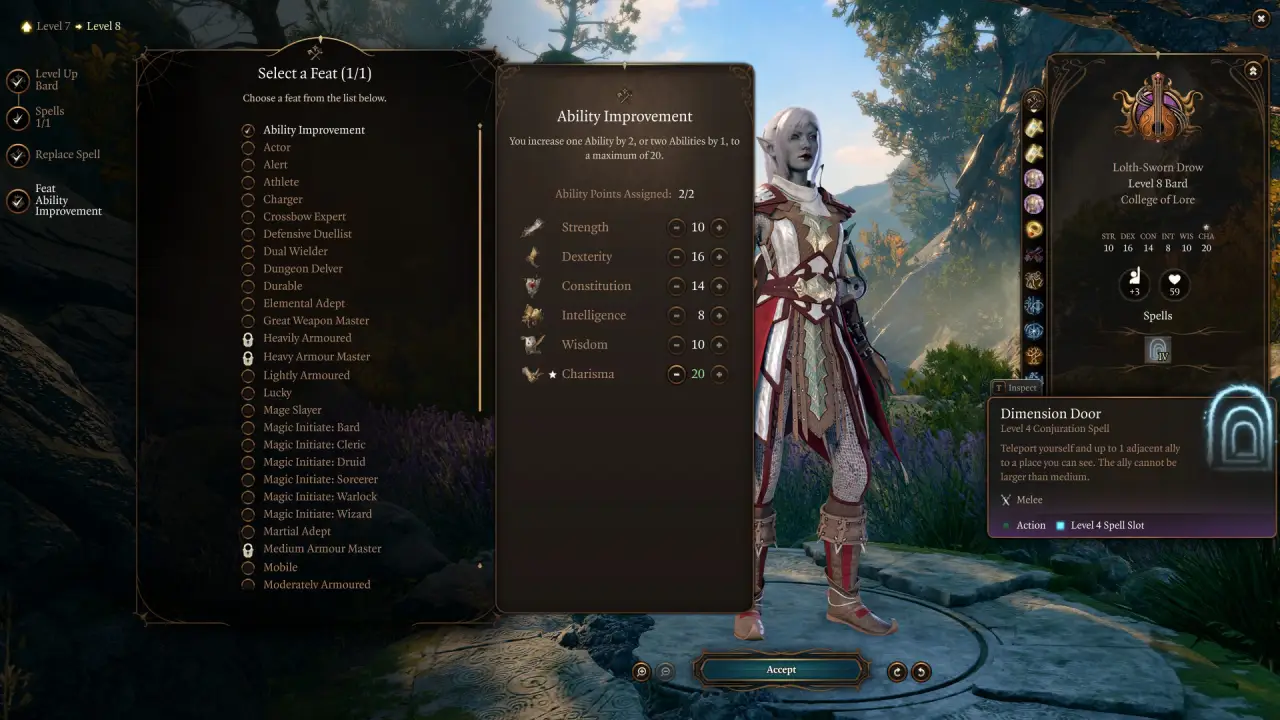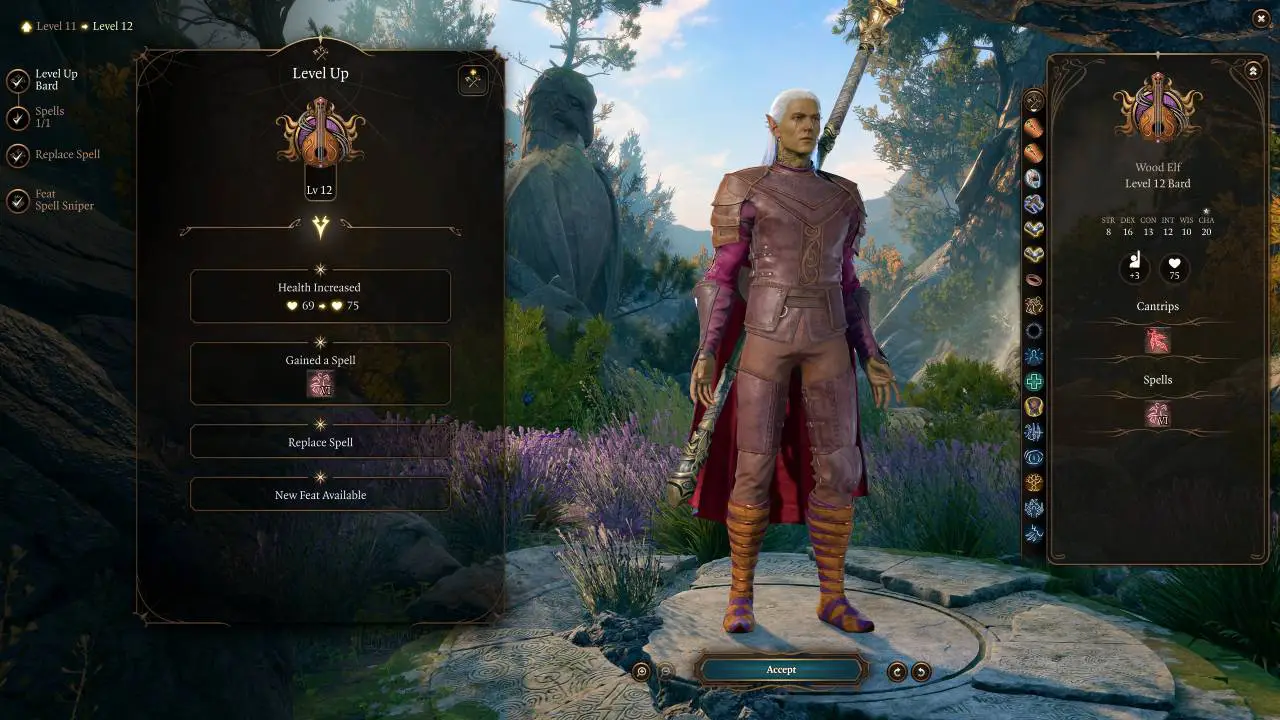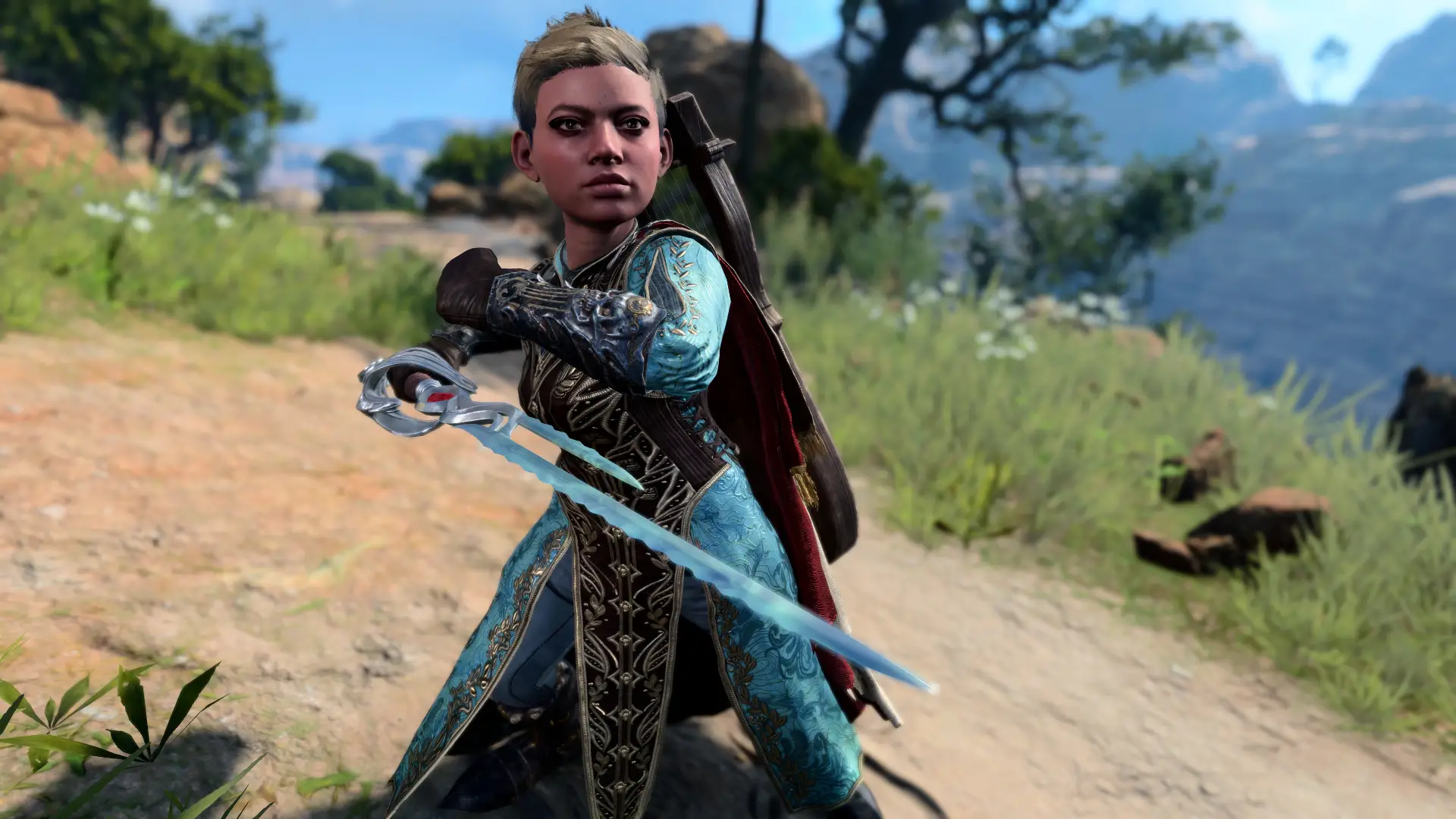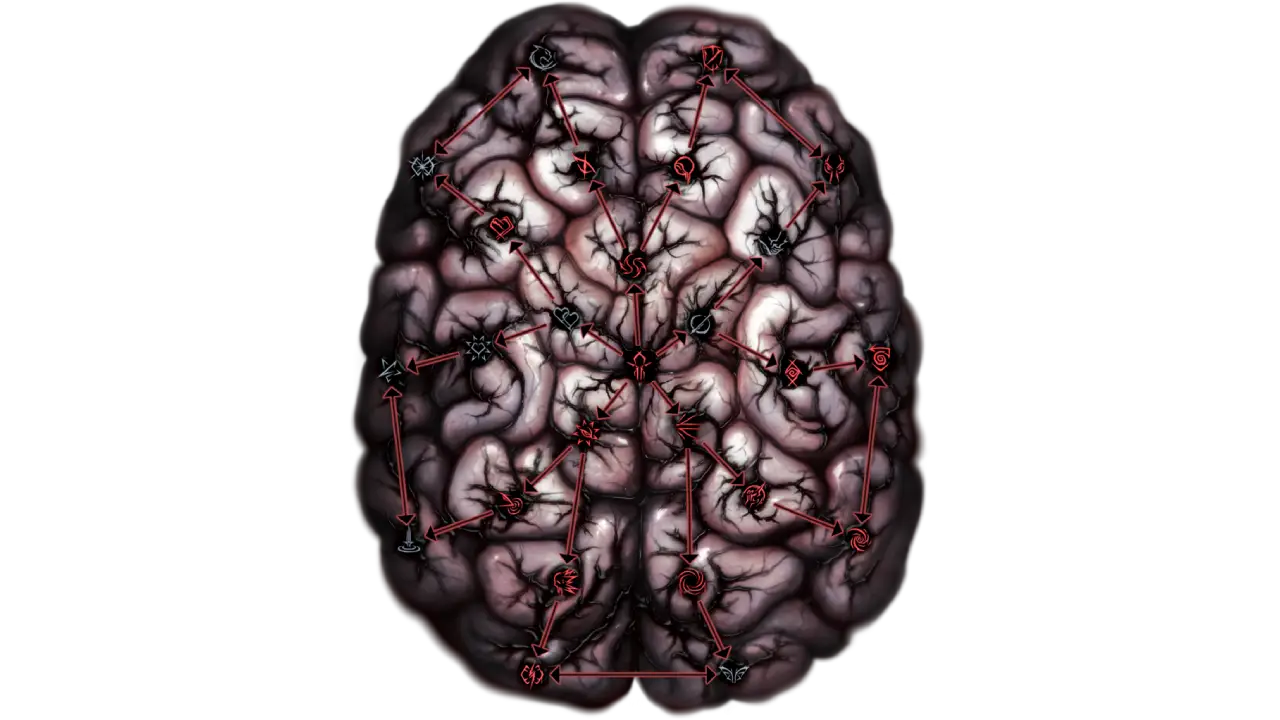Welcome to the Best BG3 Bard Build. We use the College of Lore subclass for this build in Baldur’s Gate 3. The Bard class is a spellcaster who specialises in supporting allies and confusing or debuffing enemies, but can also make for a formidable fighter by themselves.
Table of Contents for the BG3 Bard Build:
- Introduction to the Bard Class
- Bard Build Leveling Progression
- Bard Equipment
- Bard Build Extras and Tips & Tricks
Please visit our Best BG3 Builds overview page for more builds. To get an overview of all classes please visit the BG3 Classes overview page.
Bards can use the Bardic Inspiration ability to improve the odds of their allies in combat, helping them with Attack Rolls, Ability Checks or Saving Throws. Bards are both great support characters and amazing spell casters. The BG3 Bard Build works for both PC and Console (PS5 and Xbox Series X/S).
Before we continue, here is a quick overview of the Strengths and Weaknesses of the Bard in Baldur’s Gate 3:
Bard Build Strengths
Bard Build Weaknesses
BG3 Bard Class Guide
Let us take a look at the unique mechanics of the BG3 Bard class to understand how you can play the character build. Bards are expert storytellers, artist, and performers. Bards use Charisma as their primary ability score. Bards are special because you play with instruments that can play different songs. You can select your instrument of choice at character creation. It doesn’t matter what you pick here.
The Bg3 Bard Build is generally played as a support character can can increase the power of your allies and debuff enemies. However, you can also deal quite some damage due to having access to plenty of damage spells. Because the Bard is such a strong support character, you will also often get a way easier time to succeed in conversation checks and unlock new options that other setups don’t have access to. For example, Thisobald Thorm can be defeated without a fight by agreeing to drink with him, but you have to succeed strong persuasion checks. This is fairly easy to do with a Bard, but incredibly hard without a Bard supporting you.
You also get the Bardic Inspiration class action with which you can inspire allies with and add 1d6 bonus to their next Attack Roll, Ability Check or Saving Throw. This lasts until your next Long Rest and can be applied to all group members. To cast this you need Bardic Inspiration, this is the Bardic resource that can be replenished after a Long Rest. At level one you will have access to two charges. You can also use Perform on the Bard to play a song and to attract NPCs to you.
Song of Rest is obtained at level 2 and can be used to revitalise the group as it has the same effect as a Short Rest.
Later at level 5 you gain Improved Bardic Inspiration passive feature that boosts your Bardic Inspiration class action to 1d8 instead of 1d6 bonus. You also get Font of Inspiration passive feature that allows you to regain all your Bardic Inspiration after a Long or Short Rest. At level 6 you gain Countercharm, which gives you and allies within 9m Advantage on Saving Throws against being Charmed or Frightened. This will summon a magical music instrument at your place of choice for 3 turns.
At level 10 you once again gain Improved Bardic Inspiration passive feature that boosts your Bardic Inspiration class action to 1d10 instead of 1d8 bonus. Additionally, you get the Magical Secrets passive that allows you to pick two non-Bard spells up to level 5. (Note: We also get this from our subclass already at level 6, so we get to select 4 non-Bard spells in total). It is highly recommended to pick the Cone of Cold spells, which deals insane AoE damage.
BG3 Bard Subclass Comparison
The Bard has four Subclasses available: College of Lore, College of Valour, College of Swords, and College of Glamour (coming in Patch 8). Each one focuses on a different aspect of the Bard class.
| Aspect | College of Lore | College of Valour | College of Swords | College of Glamour |
|---|---|---|---|---|
| Focus | Spellcasting & Skill Expertise | Balanced Approach | Melee Combat | Healing & Support |
| Strength | Extra spells usually unavailable for Bards | Improved Bardic Inspiration | Can use more weapons & special weapon actions | Heal friends and mind-control foes |
| Weakness | No bonuses for weapon combat | Unremarkable with both weapons and magic | Neglects magical & support aspects | Not as good at direct combat |
| Best For | AoE Damage and supporting allies | Jack-of-all trades playstyle | “Spellsword” playstyle | Protecting and supporting allies |
College of Lore
You pursue beauty and truth, collecting knowledge from scholarly tomes to peasants’ tales, and use your gifts to hold both audiences and enemies spellbound.
At level 3 you first get the Cutting Words passive feature. This allows you to use a Reaction and a Bardic Inspiration Charge to give enemies a 1d6 penalty to an Attack Roll, Ability Check, or Saving Throw. You’ll also gain Proficiency in 3 extra Skills.
At level 6 you will get the Magical Secrets passive that allows you to select two additional spells, including spells usually not available to Bards. This allows you to learn two non-Bard spells up to level 3. This is great because now we can get access to Haste, which is one of the most powerful spells in the game when used correctly.
College of Valour
You wander the land to witness and relate the deeds of the mighty, keeping alive the memory of heroes of the past and inspiring heroes of the future.
College of Valour Bards lean a little towards more martial pursuits, getting Proficiency with Martial Weapons, Shields and Medium Armour, opening up more build possibilities for them. They can also make two attacks per Action with weapons, once they reach level 6. They also enjoy an upgrade to their Bardic Inspiration. Once it is applied to an ally, that ally can choose to consume it to buff one of their Attack Rolls or their Armour Class, helping to turn combat in your favour.
College of Swords
A highly trained and skilled warrior, you use your prowess with words and weapons to fight and entertain in equal measure.
As its name suggests, this subclass is more focused on martial combat than any other Bard type in BG3. You gain access to additional weapon Actions, that can boost your Armour Class when you attack, attack two enemies at once or push enemies back when you strike them. Using these special attacks will consume a Bardic Inspiration Charge. Like the College of Valour Bard, you also get an Extra Attack with your weapons once you reach Level 6.
College of Glamour
As a College of Glamour Bard, you’ll find you have the power to heal friends and command enemies in equal measure.
Cast Mantle of Inspiration to bestow your allies with 5 temporary hit points. And should an enemy attack while it is cast, they’ll find themselves Charmed.
Play your hand correctly and you’ll be able to use this to your advantage with Mantle of Majesty. Target Charmed enemies and you can command them to flee, move closer, freeze, drop to the ground, or drop their weapon.
Why Use the College of Lore Subclass for our BG3 Bard Build?
At Level 3, you get to select one of the aforementioned four Bard subclasses for your build. In this build we are using the College of Lore Bard, but why is that the best choice for the build?
The Bard has two main directions it can go in – either you make it better at fighting with weapons, augmented by spellcasting (a Spellsword, if you will), or we focus more heavily on the magical side, using weapons as more of a backup option. For this build we are taking the latter approach, because the Bard has the potential to be a very prolific support spellcaster, making allies stronger and blasting groups of enemies with multiple AoE attacks.
Playing into the Bard’s melee side isn’t a good combination with this playstyle for one simple reason: Concentration. You may be familiar with the Concentration system in BG3, but in a nutshell some of our best spells for the Bard build require Concentration to maintain their effects. Concentration is broken if you cast another Concentration Spell or, crucially, if you take damage from an enemy and fail the Concentration Saving Throw, your spell will be disrupted, potentially leaving your battleplans in tatters.
Therefore we are playing the Bard as more of a Spellcaster, and doing our best to stay away from melee combat which is most likely to get your Concentration broken. As a bonus, we get to choose two Spells that are usually unavailable for Bards at Level 6, and from the get-go we can use our Reaction and a Bardic Inspiration Charge to debuff some enemy rolls.
Character Creation (Level 1) BG3 Bard Build
In this section, we will guide you through the best options in Character Creation for the Baldur’s Gate 3 Bard Build. While you can deviate somewhat from this if you want, following these steps will result in the most powerful starting point for your Bard Build.
Race
Your race has no bearing on your Ability scores, which are the most important factor at play. This gives players more freedom to choose any race and class combination that they wish, without having to worry about being pigeon-holed into a “meta” race for their class.
However, there are still some useful passive features sourced from your race and subrace, which may be of advantage when it comes to the Bard build. Some interesting options are:
- Wood Elf or Wood Half-Elf – Gains very high Movement Speed, great for quickly taking advantageous positions and outrunning enemies.
- Gold Dwarf – Gets +1 bonus HP per Level.
- Halfling, Any – Lets you reroll your die whenever you roll a 1. This makes a Critical Miss extremely unlikely.
Class Selection
Here you want to select the Bard class. We will be able to select our subclass once we reach level 3 with the BG3 Bard Build.
Cantrips
In addition to the Spells, you’ll need to choose two Cantrips. These are less powerful spells that do not consume a Spell Slot when cast, meaning you can generally cast them every turn if you want to with no limitations. We recommend choosing the following Cantrips for your Bard build:
- Vicious Mockery – This deals a small amount of Psychic Damage to the enemy targeted, and also gives them a Disadvantage on their next Attack Roll. This is a handy debuff spell that can be used to lessen the danger of troublesome enemies.
- Light – This is a basic spell that lets you infuse an object or ally with light. It’s useful for navigating and fighting in dark places, and this spell doesn’t need Concentration so won’t mess with our other Concentration Spells, which is why we chose this instead of other more powerful light cantrips.
Spells
To start with, you’ll need to select four first level Spells for your character to learn. We recommend going with the following options for our Bard Build:
- Healing Word – This is a basic healing spell that consumes a Bonus Action rather than a regular one, allowing you to heal and attack or cast another spell on the same turn. It can also be used at long-range rather than being melee-only. The maximum healing roll on this spell is a little lower than Cure Wounds, Healing Word is still preferable thanks to its much greater versatility.
- Thunderwave – When you cast Thunderwave, your character casts a large linear AOE that knocks back anyone and anything in its path, damaging them too for good measure. Not only is this a decent AOE damage spell, it’s also very practical in combat, allowing you to create space or to knock enemies off ledges or cliffs for extra falling damage. Just be careful not to hit your friends, as the AOE is quite wide.
- Dissonant Whispers – This deals some Psychic damage to the targeted enemy, and also makes them Frightened (unless they perform a Wisdom Saving Throw). Frightened enemies have a disadvantage on ability checks and attack rolls, and cannot willingly move closer to the source of their fear (the caster). Targets remain Frightened for two turns. This is a great spell for locking down annoying or dangerous enemies.
- Tasha’s Hideous Laughter – Another great spell for locking down enemies. This causes the enemy to be overcome with fits of laughter, making them fall prone and unable to get up. The caster can maintain this effect for up to 10 turns, as long as they can maintain Concentration. Also, the target will try to shake off the effect at the end of their turn, and every time they take damage.
Starting Instrument
You can also select a starting instrument. You can pick whatever you want here. It will influence the soundscale when you cast spells, and can be changed later by simply equipping other instruments. Other than that the instrument doesn’t have any effect on combat.
Background
For your Background, we recommend choosing Entertainer. Not only does this feel like a good fit for the Bard from a backstory perspective, it also works really well with this build. Entertainer gives us the following Skill Proficiencies:
- Acrobatics – This is a Dexterity-based Skill that gives you a resistance to enemy Shove actions.
- Performance – A Charisma-based Skill that will sometimes appear as a Dialogue option, allowing you to sway some NPCs to do what you want, or simply impress them.
Ability Points
As a Bard, our most important ability is Charisma, which is used to determine the effectiveness of our spellcasting. Other important abilities are Dexterity, which boosts our Armour Class, and Constitution, which increases our Hitpoints and improves our Concentration Checks.
It is also important to note that for most in-game calculations, our Ability Modifier is what matters, not the Ability score itself. The Ability Modifier starts at 0 and goes up by 1 for every 2 extra points we have in an ability, for example 10 = 0 modifier, 12 = 1 modifier, 14 = 2 modifier, etc. We can also have a negative modifier if a Skill is below 10, which should always be on the least important Ability.
Taking all of this into account, we recommend this Ability distribution as your starting point:
- 10 Strength
- 16 Dexterity
- 14 Constitution
- 8 Intelligence
- 10 Wisdom
- 16 Charisma
Skill Proficiencies
Choose any Skills that are based on Charisma or Dexterity. We went with Deception, Intimidation and Persuasion, which will give you an easier time in most dialogue rolls.
Bard Weapons and Armour
The BG3 Bard Build has access to plenty of weapon types that you can equip and use without any downside. Here you can see what Weapons and Armours your Bard can use at the start of your adventure:
- Weapons: Simple Weapons (Daggers, Clubs etc), Hand Crossbows, Longswords, Rapiers, Shortswords, Longbows, Shortbows
- Armours: Clothes and Light Armour
Any Proficiencies unlocked from your chosen Race will be added to the above Proficiencies.
More info on what and where you can find suitable gear in the BG3 Bard Build Equipment section further down the page.
Early-Game Levelling for the BG3 Bard Build
Now, we are going to look at how to level up your College of Lore Bard Build for Baldur’s Gate 3. In this section we’ll cover the first four levels, including your first spells and first Feat.
Level 2 – Spells
At Level 2, the BG3 Bard Build unlocks a couple of its class abilities.
Firstly, we get the Jack of All Trades passive, which gives us half of our proficiency bonus (rounded down) in any Ability Checks that we’re not proficient with. This is particularly useful for out of combat encounters, slightly increasing our odds of increasing even in disciplines that we haven’t built around.
Secondly, we unlock the Song of Rest ability. This can be used both inside and outside of combat, and revitalises your party as though you took a Short Rest. This is especially useful on Tactician and Honour modes, where Camping Supplies are used up twice as fast.
Finally, you’ll be able to choose one more Spell to learn. Here, we went with the Sleep spell. This is a really good early-game control spell that cannot be blocked by enemies, as long as they are under the spell’s maximum HP threshold. The downside is that any damage dealt to the victim will wake them up. If someone else in your party already has the Sleep spell, then go with either Faerie Fire or Bane, which are both useful debuff spells that can affect multiple creatures at once.
Level 3 – Subclass and Spells
When you reach Level 3, you’ll need to choose your subclass. For this Bard build we are using the College of Lore, which gives us proficiency in Arcana, Intimidation and Sleight of Hand, as well as access to the Cutting Words ability. Cutting Words allows you to debuff the damage, Attack Roll and Ability Check values of an enemy.
You’ll also be able to choose two skills that you’re already proficient in and have the proficiency bonus doubled for those skills. This allows your character to become very good at certain difficulty checks such as persuasion, lockpicking and other such events. We recommend choosing Persuasion and one other skill of your choice, depending on your playstyle and what you would like your character to specialise in the most. Performance is probably the most thematic choice for a Bard, but Deception and Intimidation are more frequently used in dialogue events. You could also choose Stealth or Sleight of Hand if you’re using your Bard for sneaking or lockpicking a lot.
Finally, you will have to choose another new spell. At this point, we’re able to include some second level spells. We recommend going with Cloud of Daggers. This creates a small AOE that does pretty high damage each turn, but requires concentration to maintain. It’s especially useful in chokepoints or on a group of enemies who are immobilised or stuck in a small space for any other reason. The spell also hits allies, so be careful when placing it.
Level 4 – Feat, Spell and Cantrip
All characters in Baldur’s Gate 3 need to choose a Feat when they reach Level 4. These provide an extra buff or ability for your character and are great for further customising your build. It’s recommended to choose Ability Improvement, which will give you 2 more ability points to spend. Put both of these points into Charisma, which will take up your Charisma score to 18. Boosting your Charisma will improve your Spellcasting, helping to keep up with the tougher enemies you’ll encounter as you reach higher level parts of the map. It’s also helpful for Charisma-based Skills like Persuasion.
Next up, we need to choose another spell for our Bard Build in Baldur’s Gate 3. We recommend choosing Enhance Ability, a very strong support spell that gives Advantage on all checks related to a selected Ability, for the spell’s duration. Advantage means that instead of 1 dice, we roll 2 dice and automatically choose the one with the best roll. This spell is awesome in combat when cast on a damage-dealer in your party, and can also be very helpful to pass high-DC dialogue checks. Once cast, the spell lasts until your Concentration is broken, so try to keep your Bard away from enemy attacks as much as possible. Also, casting another Concentration spell, like Cloud of Daggers, will put an end to the spell, so try to plan your character’s moves around only one Concentration Spell.
As for the Cantrip, we’ll be going with Blade Ward. This isn’t something that gets used super-often, but sometimes you may find yourself on a turn where your Bard can’t make any good attacks, and if that happens you can use Blade Ward to get 50% damage resistance to physical attacks.
Mid-Game Leveling – Bard Build Levels 5-8
In this section we’ll cover the mid-game. During these levels, your Bard will become much more powerful, accessing a wider array of spells.
Level 5 – Improved Inspiration and Spell – PS5/PC
At Level 5, the BG3 Bard Build becomes considerably more powerful.
First of all, your standard Proficiency bonus is increased to 3 rather than 2, making you even better at the skills you’re proficient in.
You also gain the Font of Inspiration passive feature, which lets you replenish your Bardic Inspiration Charges with a Short Rest. The bonuses from Bardic Inspiration are also increased.
These are some nice buffs already, but at Level 5 we also get to pick a third level spell. We highly recommend choosing Glyph of Warding. This is a very powerful spell that lets you place a 8-metre wide magical trap on the ground. With each cast, you can choose from the following types of Glyph:
- Sleep – Puts everyone in range to sleep for 2 turns when triggered.
- Detonation – Emite a gust of wind that pushes back all within.
- Thunder – Deals 5-40 Thunder Damage to everyone in range.
- Lightning – Deals 5-40 Lightning Damage to everyone in range.
- Fire – Deals 5-40 Fire Damage to everyone in range.
- Cold – Deals 5-40 Cold Damage to everyone in range.
- Acid – Deals 5-40 Acid Damage to everyone in range.
These effects have a Dexterity Saving Throw. The Glyph types that deal damage will still deal half of their damage to targets who succeed at the Saving Throw. You can place the Glyph underneath an enemy, detonating it immediately. If you get a high damage roll then you can decimate entire groups of enemies very quickly with this spell. Just be very careful that you don’t catch yourself or your allies in the AOE, because you could potentially one-shot them, even from full health.
Level 6
At Level 6, you’ll gain an additional Third Level Spell Slot, giving you three of these in total.
In addition, you’ll gain the following abilities:
- Countercharm – You and any allies within 9 metres have Advantage on Saving Throws against being Charmed or Frightened.
- New Spell – We recommend learning Hypnotic Pattern.
- Magical Secrets – Lets you learn two Spells (up to third level) from the Spell Lists of other classes. Depending on if you’re using your Bard for more of a damage or support role, we recommend choosing both of the following:
- Call Lightning – Call down lightning to hit all targets within range and its area of effect for 3-30 Lightning damage. Each turn, you can use an Action to call down lightning again without expending a spell slot. On a successful save, targets still take half damage. Later on we can Upcast this for even more AoE damage.
- Haste – Target yourself or an ally to become Hastened. The creature has a +2 bonus to Armour Class, Advantage on Dexterity Saving Throws, its Movement Speed is doubled, and can take one additional Action per turn. When the condition ends, the creature becomes Lethargic.
You might be wondering why we’ve recommended two AoE spells – Glyph of Warding and Call Lightning. Glyph of Warding is useful in situations where enemies are Resistant to Lightning Damage (you can choose a non-lightning variant), or when you’re already Concentrating on a spell and don’t want to break it. Call Lightning deals less damage per attack than Glyph of Warding (on average), but it can be reused every turn as long as you keep Concentration, so it’s more efficient over longer fights where you need a lot of AoE damage.
Both of the options we’ve recommended for Magical Secrets are Concentration Spells. Call Lightning lets you deal really high amounts of Lightning AOE damage each turn, as long as you keep Concentrating on the spell. Haste lets you turn someone in your party into a damage machine, giving them an extra Action each turn. If you have another Spellcaster in your Party who already has Call Lightning or a similar Concentration Spell, then casting Haste on them will allow them to reactive the spell’s effect twice per turn. It also works great on strong melee damage dealers, like Barbarians or Fighters.
Level 7
At Level 7 you’ll gain a Fourth Level Spell Slot, and you can choose one more spell to prepare. We recommend choosing a Fourth Level Spell so you can immediately make use of your more powerful magical options.
A really useful spell to get here is Dimension Door, which lets you teleport yourself and one adjacent ally to a location that you can see. This is great for getting out of trouble, or getting into a high ground position.
Level 8
At Level 8, we get to pick another Feat for our College of Lore Bard Build in BG3. Once again, we recommend choosing Ability Improvement. Use the points to improve your Charisma to 20, giving you the highest possible spellcasting ability and improving your Charisma Modifier.
We also unlock another spot for a Prepared Spell. We recommend choosing Confusion, a Concentration Spell which will confuse a group of enemies, causing them to attack creatures at random (including each other), run around aimlessly, or skip their turn entirely. This effect can last for up to 3 turns. This has a Wisdom save, so you’ll get the best results when casting it on enemies with low Wisdom. Be sure to Examine enemies to see their stats before deciding if it is worth casting this or not!
You’ll also gain another Fourth Level Spell Slot here, giving you two in total.
Late-Game Bard Leveling – Levels 9-12
By the time you reach these levels, you are probably near the end of Act II or already in Act III. Here we will unlock the most powerful spells available for the Build, and finish things off with the War Caster Feat, allowing you to be much more resilient when maintaining Concentration Spells.
- Level 9 – Tier 5 Spells
- Level 10 – Magical Secrets
- Level 11 – Tier 6 Spells
- Level 12 – War Caster Feat
Level 9
At Level 9, you gain one more Fourth Level Spell Slot, giving you a total of three.
You also gain your first Fifth Level Spell Slot, and are able to prepare one more spell for use.
We recommend getting the Hold Monster Spell, a Concentration Spell that allows you to Paralyse a creature, preventing them from moving or reacting, and guaranteeing Critical Hits against them when you attack from within a three metre distance. This spell has a Wisdom save, so you may have a low chance of success against enemies with high Wisdom with your Bard Build.
Level 10
At Level 10, your BG3 Bard Build will gain a few new features and buffs:
- Another Fifth Level Spell Slot, giving you two in total.
- Improved Bardic Inspiration – Bardic Inspiration now gives a bonus of 1-8 instead of 1-6.
- Gain Expertise in another two Skills you are Proficient with, doubling the Proficiency Bonus for those Skills.
- You get to use Magical Secrets again, allowing you to choose another two Spells from outside the Bard Spell List. We recommend going for:
- Banishment – Banish the target to another plane of existence for 2 turns. Requires Concentration.
- Cone of Cold – Make a flurry of frost, crisp air, and condensed snow crystals erupt from your hands. Deals 8-64 damage up to a distance of 9 metres. On save: Targets still take half damage.
These two extra Spells give the Bard some new options for controlling dangerous enemies, or dealing high amounts of damage themselves.
Additionally, you can select another Spell, we recommend picking Mass Cure Wounds. You can also select another Cantrip, and pick whatever you like the most.
Level 11
At Level 11, you gain access to Sixth Level Spells. You’ll only ever get one Spell Slot for this level of magic, so the spells can only be cast once per Long Rest.
You’ll be able to unlock one additional Spell – we recommend choosing Eyebite, a Concentration Spell that lets you inflict dread, sickness or put the target to sleep. As long as you keep concentrating, you can cast the spell again on each subsequent turns.
Alternatively, you can get Otto’s Irresistible Dance. This is a weaker spell than Eyebite, but it’s probably a more funny and thematic option for a Bard to have, as it literally compels the target to begin dancing uncontrollably.
Level 12
If you’ve reached this point, then you have successfully levelled your Bard build up to the maximum level. Congratulations!
First we can select a new Spell, we recommend Otto’s Irresistible Dance which causes enemies to start dancing uncontrollably.
Additionally, we get to select another Feat. We recommend getting War Caster, which gives you Advantage on Concentration Saving Throws, making it considerably more likely that your Bard will retain Concentration when they take damage. We’re using quite a lot of Concentration spells on this build, making this Feat a good fit. As a bonus, you can cast Shocking Grasp as a Reaction against enemies who move past your character.
Best BG3 Bard Build Equipment
Now, let us take a look at what equipment your Bard Build can use. You will find an early game and an endgame setup below. The early game gear can be acquired in Act 1 and at the start of Act 2. The endgame gear is from late Act 2 and Act 3. Sometimes, we also add alternatives in case a part of the gear is hard to obtain.
Early Game Gear
This early game gear setup for our Bard Build with College of Lore subclass can be acquired in Act 1 and early Act 2. You don’t need to follow this to the tail, but it is recommended to read through it so you understand what each piece of gear can do. Some items are bard-specific and can really improve your build and gameplay.
Plenty of the early game equipment triggers off our Bardic Inspiration. Next to our Bard instrument, we can find an actual singing sword in Act 1, which is pretty cool too.
| Slot | Icon | Item | Effects | Location |
|---|---|---|---|---|
| Head |  |
Cap of Curing |
|
Inside the Druid Grove in a Gilded Chest next to Alfira |
| Cloak |  |
Cloak of Protection |
|
Purchased from Quartermaster Talli in Last Light Inn |
| Chest |  |
Blazer of Benevolence |
|
Complete the Rescue Volo quest |
| Gloves |  |
Wondrous Gloves |
|
Mimics encounter inside the Grymforge in the Underdark |
| Boots |  |
Boots of Aid and Comfort |
|
Purchase from Grat the Trader inside the Goblin Camp |
| Necklace |  |
Amulet of the Harpers |
|
Buy from Quartermaster Talli at the Last Light Inn |
| Ring 1 |  |
Ring of Protection |
|
Steal the Sacred Idol in Druid Grove (quest) |
| Ring 2 |  |
Whispering Promise |
|
Buy from Grat the Trader inside the Goblin Camp |
| Main Weapon |  |
Phalar Aluve (or Longsword +1) | In the Underdark, stuck inside a rock. You must pass a 15 Strength Check to pull it out. | |
| Second Weapon |  |
Shortbow +1 |
|
Buy from trader Roah Moonglow |
Now let us take a look at what the gear does and where you can get it from.
Cap of Curing
The Cap of Curing is an easily obtainable item. Whenever you inspire an ally using your Bardic Inspiration, they also regain 1d6 Hit Points. The Cap of Curing can be found inside the Druid Grove in a Gilded Chest next to Alfira, the singing bard.
Cloak of Protection
The Cloak of Protection is one of the few cloaks in BG3 that you can get right at the start of Act 2. This item can be purchased from Quartermaster Talli in Last Light Inn, it doesn’t cost that much either so it is a good pick. The cloak adds an extra +1 Armour Class and +1 Saving Throw to your character.
You can also read our in-depth guide on How to get the Cloak of Protection in BG3 which explains everything in detail.
Blazer of Benevolence
The Blazer of Benevolence is another Bard-themed item that you can get in BG3. You gain 4 Temporary Hit Points when you inspire an ally using Bardic Inspiration. Extra health is always a good thing to have. You can acquire the blazer at the Shattered Sanctum, as a reward by completing the Rescue Volo quest. Volo is first seen in the Druid Grove, then you see him at the Goblin Camp entertaining the Goblins and afterwards you can find him inside the Shattered Sanctum.
Wondrous Gloves
The Wondrous Gloves increase your Armour Class by 1 and give you an additional Bardic Inspiration Charge. This item comes a bit late in Act 1, it will drop from the Mimics encounter inside the Grymforge in the Underdark. Once you are in the Underdark, you have to take a boat to get to the Grymforge.
Boots of Aid and Comfort
The Boots of Aid and Comfort are great together with The Whispering Promise ring because they synergize with each other. The boots give you 3 Temporary Hit Points when you heal a target.
You can buy them from Grat the Trader inside the Goblin Camp in Act 1 of BG3. Sometimes traders won’t have all items available at the same time. You can use a Long Rest to reset the traders items, you don’t need to use any camp supplies. You might have to try several times until the item shows up.
Amulet of the Harpers
The Amulet of the Harpers is a good Amulet, it gives you Advantage on Wisdom Saving Throws and Checks and more importantly the Shield spell that allows you to use your reaction to increase your Armour Class by 5. Additionally, you take no damage from enemy Magic Missiles.
The Amulet of the Harpers can be bought from Quartermaster Talli at the Last Light Inn at the start of Act 2 in Baldur’s Gate 3.
Ring of Protection
The Ring of Protection is a really good ring that you can obtain early in Act 1. The ring gives you a +1 to Armour Class and +1 to Saving Throws. You get the ring by completing the Steal the Sacred Idol quest. To start the quest head into the Tiefling Hideout in the Druids Grove and talk to Mol. She is the gang leader and wants you to steal the Idol of Silvanus. The Idol is used as a ritual in the middle of the Druid, it won’t be easy to steal it.
Whispering Promise
The Whispering Promise ring applies Blessed to a healed creature. Giving them a 1d4 bonus to Attack Rolls and Saving Throws for 2 turns. This ring synergizes well with the Cap of Curing and the Boots of Aid and Comfort.
You can buy them from Grat the Trader inside the Goblin Camp in Act 1 of BG3. Brem inside the Zhentarim Hideout also has the item. Roah Moonglow also has the item. Sometimes traders won’t have all items available at the same time. You can use a Long Rest to reset the trader’s items.
Pahalar Aluve
Phalar Aluve is a sword that can sing and shriek. If you decide to use the sing action allies within 6m have a 1d4 bonus to Attack Rolls, Charisma, Widom and Intelligence Saving Throws. The sword can be found in the Underdark, it is stuck inside a rock. You need to pass a 15 Strength Check to be able to pull it out.
If you don’t know how to get into the Underdark, then please read our How to enter the Underdark in BG3 guide.
Longsword +1 (Alternative)
The Longsword +1 is a good starter weapon. Roah Moonglow is selling the weapon inside the Shattered Sanctum. If you do not see the weapon in her wares, then take a Long Rest (Don’t need to spend supplies) and return to the Roah. This should reset her items, and the Longsword+1 should appear. You might have to do this several times because trader inventory is random.
You can also read our in-depth guide on How to get the Longsword or Shortsword +1 in BG3 to get a detailed walkthrough on how to obtain the sword.
Shortbow +1
The Shortbow +1 can also be found on the trader Roah Moonglow like the Shortsword +1. You can use pretty much any ranged weapon you are proficient in as Bard. The Shortbow +1 is a good early game weapon and easy to get.
Endgame Gear
The endgame gear setup is built together with items from late Act 2 and Act 3. While you don’t need all these items, it is recommended to get as many as possible to increase the overall power of the Bard Build.
| Slot | Icon | Item | Effects | Location |
|---|---|---|---|---|
| Head |  |
Hood of the Weave |
|
Can be bought from Mystic Carrion inside his Philograve’s Mansion |
| Cloak |  |
Cloak of the Weave |
|
Sold by Helsik at the Devil’s Fee once you unlock her “special stock”. |
| Chest |  |
Potent Robe |
|
Complete Rescue the Tieflings, then get the reward from Alfira at Last Light Inn. If Alfira is dead, you won’t get this reward! |
| Gloves |  |
Helldusk Gloves |
|
Defeat Haarlep and loot the gloves from him |
| Boots |  |
Helldusk Boots |
|
Lord Enver Gortash’s personal chest |
| Necklace |  |
Amulet of Greater Health |
|
Inside the Archive in the House of Hope |
| Ring 1 |  |
Ring of Regeneration |
|
Buy from either Rolan or Lorroakan’s Projection at Sorcerous Sundries. |
| Ring 2 |  |
Whispering Promise |
|
Buy from Grat the Trader inside the Goblin Camp |
| Main Weapon |  |
Duellist’s Prerogative |
|
Complete the Save Vanra quest in the Lower City |
| Second Weapon |  |
The Dead Shot |
|
Sold by Fity the Firecracker trader in the Lower City |
Now let’s see what the endgame gear does for our BG3 Bard Build and where you can find it.
Hood of the Weave
The Hood of the Weave is a powerful item. You gain a +2 bonus to Spell Save DC and spell Attack Rolls. The Hood of the Weave can be bought from Mystic Carrion inside his Philograve’s Mansion in the lower city of Baldur’s Gate in Act 3.
Cloak of the Weave
The Cloak of the Weave gives you +1 bonus to Spell Save DC and Spell Attack Rolls. Additionally, you can also absorb elemental damage once per short rest. That way you only take half the damage from the next elemental attack. You will also deal 1d6 of that type on your next attack.
The Cloak of the Weave is sold by Helsik at the Devil’s Fee once you unlock her “special stock”.
Potent Robe
The Potent Robe is a very rare cloth that allows your cantrips to deal additional damage equal to your Charisma Modifier. Additionally, you also gain Temporary Hit Points equal to your Charisma Modifier. And because the Bard’s main stat is Charisma, these values are high.
To obtain it, complete the quest to Rescue the Tieflings, and hand the quest in at Last Light Inn. Alfira must be alive, or else you won’t get this reward.
Helldusk Gloves
The Helldusk Gloves give you +1 bonus to Spell Attack Rolls and Spell Save DC. Your weapon attacks also deal an additional 1d6 Fire damage and you gain the Rays of Fire spell.
You can get the Helldusk Gloves inside the House of Hope by defeating Haarlep and looting them from him. You reach the House of Hope by solving the ritual in the top floor that will open the gate to the House of Hope. This is a tough area, Raphael might want a word with you if you are trying to get out of there with his stuff!
Helldusk Boots
The Helldusk Boots are very rare boots that you can acquire in Act 3. You cannot be forcibly moved by a foe’s spells or actions, and you ignore the effects of Difficult Terrain. And even more important, you get the Hellcrawler action. Think of this as a secondary Misty Step, now you can teleport up to 18m and deal fire AoE damage. This will improve your mobility.
The Helldusk Boots can be found in Lord Enver Gortash’s personal chest at the upper levels of Wyrm’s Rock Fortress. The upper levels can be reached through the gate on the main floor. Best to bring some Invisibility potions to pull this off without alarming everyone in the fortress.
Amulet of Greater Health
The Amulet of Greater Health is another item that is immensely powerful. It will boost your Constitution score to 23, increasing your health tremendously. Like the Gauntlets of Hill Giant Strength and Orphic Hammer, it can also be found inside the Archive in the House of Hope that you reach via Devil’s Fee.
You can also read our in-depth guide on How to get the Amulet of Greater Health in BG3.
Ring of Regeneration
The Ring of Regeneration lets you restore 1-4 Hit Points at the beginning of your turn. The ring synergizes well with The Reviving Hands, Hellrider’s Pride, The Whispering Promise and Boots of Aid and Comfort. You could sort of create a chain reaction with all these items if you want to.
Buy the ring from either Rolan or Lorroakan’s Projection at Sorcerous Sundries. If Lorroakan is dead, you may still be able to pickpocket the ring from Rolan at Ramazith’s Tower.
Duellist’s Prerogative
The Duellist’s Prerogative is a legendary Rapier item. When your off hand is empty, you only need to roll a 19 for a Critical Hit, you also gain an additional Reaction per turn, which is great for our Bard. You also get Dueller’s Enthusiasm that allows you to make an additional melee attack. You also get Challenge to Duel, sort of like a taunt, also inflicts bleed on the enemy. lastly, on a hit with a melee weapon, use a reaction to deal additional Necrotic damage equal to your Proficiency Bonus.
You can get the Duellist’s Prerogative by completing the Save Vanra quest in the Lower City of Baldur’s Gate. You start the quest at here at the Basilisk Gate.
The Dead Shot
The last item on the menu is the The Dead Shot longbow. When you have this equipped, you once again need 1 point less to do a Critical Hit. Also has a +2 Enchantment and it doubles your Proficiency Bonus when you roll ranged attacks with this weapon.
The Dead Shot is sold by Fity the Firecracker trader in the lower city of Baldur’s Gate. It is likely that you equip this by another character in your group. Therefore any other ranged weapon that you are proficient with will also do just fine on your Bard Build in BG3.
BG3 Bard Build Tips and Tricks
It’s useful to keep in mind that Bardic Inspiration is a Bonus Action, so you don’t need to worry about using up your turn to buff allies this way – you can Inspire them and cast another regular ability in the same turn.
In the early game you will feel a little bit limited with how much you can use Bardic Inspiration. Once you hit Level 5 this ability will start feeling much stronger and more readily available, as you’ll be able to replenish it with Short Rests.
The Bard’s spells do not make use of Attack Rolls, which is both a good and bad thing. It’s good because your spells will not miss – your opponents chances of avoiding or mitigating your spell damage will depend only on their Saving Throws, where applicable. However, the drawback is that your spells cannot Crit, because Critical Hits happen as a result of the Attack Roll system. Note that this system is separate from Damage Rolls. A dice roll still occurs to decide how much damage the spells do.
Top 5 Bard Build Spells in Baldur’s Gate 3
Here are five of the most important spells for this Bard Build in BG3.
1. Call Lightning
A very efficient AoE damage spell. Call Lightning hits a target area with Lightning damage. You can keep reusing the spell without spending a Spell Slot, as long as you retain Concentration on the spell. If your character is Hastened, you can even cast it twice per turn.
Getting the most out of this spell requires you to be careful to avoid taking damage, as each time you take damage there is a chance you’ll lose Concentration. Used correctly, you can dispatch a great deal of enemies with consecutive AoE strikes.
Call Lightning is only available from the Magic Secrets feature, unlocked by College of Lore Bards at Level 6.
2. Haste
Another Concentration spell, Haste lets you target yourself or an ally and give them the Hastened buff for the spell’s duration. This increases their Movement Speed, gives them an extra Action each turn, a +2 bonus to Armour Class and an Advantage on Dexterity Saving Throws.
This spell is best cast on your party’s most powerful damage dealer, and tends to be especially effective on melee powerhouses like Barbarians and Fighters. When the spell ends, the target will become Lethargic, preventing them from doing anything for one turn. Therefore it’s important not to cast the spell when you’re likely to get hit in the next couple of turns, otherwise you may end up just debuffing your target for no real benefit.
This spell also comes from the Magic Secrets feature.
3. Hold Monster
A powerful stun that completely paralyses an enemy who fails to resist the spell. All melee hits against the stunned target are guaranteed Critical Hits, so using this in coordination with a strong melee damage dealer is a great way to do big bursts of damage.
The affected enemy can make a new Saving Throw each turn to attempt to break free, and your Bard also needs to maintain Concentration on the spell.
Earlier in the game, you have the option of using Hold Person which has the same effect but only works against living humanoid targets.
4. Dimension Door
Dimension Door allows you to teleport yourself and one nearby ally to another location that you can see. It is like an upgraded version of Misty Step. This is great for getting out of trouble, or for transporting two characters to take on an enemy who is causing problems from a distance.
It’s easy to overlook this spell because its effects don’t sound especially powerful, but having a lot of mobility is a real asset in BG3.
5. Glyph of Warding
Place a glyph on the ground which detonates when touched. You can place the glyph under an enemy to detonate it immediately, which is handy for doing a quick burst of AoE damage without needing to commit to a Concentration Spell like with Call Lightning. You can also use Glyph of Warding to disrupt enemies with Sleep or a gust of wind, but we usually prefer to use the damage variants.
This spell has variants that deal Thunder, Lightning, Fire, Cold or Acid damage. Make sure you Examine your targets to check if they are Resistant or Vulnerable to a certain damage type before choosing which variant of the spell you will use.
Bard Build Illithid Powers (optional)
Illithid Powers are unlocked later in BG3 when you learn more about Mind Flayers and Tadpoles. By eating Jars of Mind Flayer Parasites you gain one point. This is another optional skill tree that you can get access to if you want. Here are some of the best Illithid Powers for the BG3 Bard Build with the College of Lore subclass:
- Concentrated Blast: Allows you to deal extra damage to a target when you are Concentrating on a spell, potentially also healing if the target is Concentrating too.
- Cull the Weak: When you reduce a creature’s hit points below a certain threshold, this power instantly kills it and deals 1-4 psychic damage to nearby enemies. This is particularly effective when engaging groups of weaker foes, enabling you to thin their numbers rapidly.
- Fly: This can be used to reach hard to get to places or change positions in combat.
- Black Hole: This power creates an area-based effect that pulls in and slows targets. It’s particularly useful for crowd control, allowing you to cluster enemies together for area-of-effect attacks or to isolate them from vulnerable allies.
- Psionic Backlash: This is a top tier reaction from the Illithid Powers skill tree in BG3. This allows you to deal psychic damage when a nearby enemy casts a spell. This is especially useful if the target is casting a Concentration Spell. The damage from Psionic Backlash can immediately break their Concentration, ending the spell’s effects.
Other Baldur’s Gate 3 Builds
- Druid Build – Circle of the Moon
- Ranger Build – Hunter
- Monk Build – Way of Shadow
- Monk Build – Way of the Four Elements
- Monk Build – Way of the Open Hand
- Necromancer Build – Necromancy
- Fighter Build – Battle Master
- Barbarian Build – Berserker
- Warlock Build – Great Old One
- Cleric Build – Light Domain
- Rogue Build – Thief
- Sorcerer Build – Wild Magic
- Wizard Build – Evocation School
- Paladin – Oath of Ancients
- More Baldur’s Gate Guides & Builds



